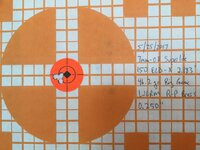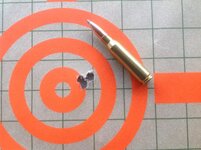- Messages
- 4,273
- Reactions
- 10,734
When I clean I use Wipe-Out foaming bore cleaner. Follow the directions.
P
P
Follow along with the video below to see how to install our site as a web app on your home screen.
Note: This feature may not be available in some browsers.
Perhaps some of you have seen this, many have not. Please forgive me if it's already been posted, but it's good and it's from a renowned match winning barrel maker.
How to Break-in a Barrel
Better yet, get used to it while you "break it in"
That works for ARs but I don't have one (sold my guns for a fresh start. Haven't found one I like yet. I am finicky, don't judge) nor do I plan to get one anytime soon. I prefer Bolt action rifles which was what I was talking about.I suppose the "break in" phenomenon is a result of a combination of field testing a firearm for reliability, and "fielding" the platform by the operator or user. As a rule of thumb breaking in a firearm is very specific to the manufacturer. Precision manufacturing and high-quality control yields a gun that runs and cutting corners yield a gun that might not run without fitting or modifications. I just read the AR study and I think something we seldom think about is the major differences in cartridges and their respective projectiles and how they wear the barrel. Some projectiles (bullets) wear a barrel out fast, some are very easy on the rifling. And as McMillan mentions some cartridges are just hard on barrels. I would think we can develop better projectiles and better barrels to extend the lifespan of these barrels. This would be a good market considering out troops are fielding .300+ sniper platforms in the combat zone. Think about the benefits of doubling the lifespan of a .300 barrel for snipers. Loss of mean velocity and accuracy would be increased 200% over the lifespan of the barrel. It's not uncommon for a sniper to take hundreds of shots while deployed in the modern era. Historical kill counts are also indicative that a sniper may be placed in a position where 1000 round lifespan is a liability. Training and certification rounds, and rounds in combat could use that rifle up fast. Depending on the platform cleaning may or may not have an adverse effect on mean accuracy and barrel wear. From my experience, I don't like a clean bore on a precision rifle. I just feel more comfortable with a few rounds through the barrel, the first shot on a well-swabbed barrel seems to yield more deviation in a pressure for several reasons. 1. temp 2.residual lube 3. friction variations on the inside of the barrel. I have found that the cheap ammo in my semi-automatics can be corrosive to some degree and It's more important to run a swab of solvent and lube down the chamber and barrel. I can give some good advice: if you shoot cheap Russian ammo in your AR or AK, expect excessive barrel wear. If you're a thrifty type, you might want to stick with American made factory ammo. If you are a high volume shooter, you can probably afford to replace a $200 barrel every year but considering any projectile with steel in it can cause mean accuracy to drop at 1/2 the lifespan of nonsteel projectiles it is worth noting.
I have a very detailed and meticulous process. Its straightforward but complex.
Insert bolt
View attachment 341579
Mount a scope
View attachment 341582
Boresite
View attachment 341580
Go to the range
View attachment 341581
Shoot the heck out of it
View attachment 341583
Go home
View attachment 341584
Put it away
View attachment 341587
View attachment 341585 View attachment 341586
P
YOU FORGOT TO MENTION THE VERY FIRST STEP IN YOUR BREAK IN PROCEEDURE!!!!!
BUY A TIKKA RIFLE!
I just got another Tikka in 7mm-08 and broke in the barrel yesterday morning. After shoot & clean for 5 rounds while sighting in the scope I noticed that the bore felt very smooth and was not offering up much crud on the cleaning patches. So I decided to shoot a 3 shot group. Shots number 6, 7, & 8 went into a .484" group at 100 yards. Cleaned it after that first group and shots number 9, 10, & 11 went into a .367" group at 100 yards. I think that the folks at Tikka/Sako have got it down when it comes to building rifles that shoot very well for an off the shelf option.
First step in the barrel break in process is start with a good barrel!

